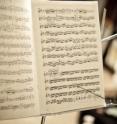Method developed to identify musical notes at any venue
A team of telecommunications engineers from the University of Jaen (UJA) has created a new method to automatically detect and identify the musical notes in an audio file and generate sheet music. The system identifies the notes even when the type of instrument, musician, type of music or recording studio conditions vary. "We propose an automatic system to detect and transcribe musical notes for one-instrument musical signals which, unlike other methods, is capable of adapting to the music scene", Julio José Carabias, co-author of the paper and a researcher from the Department of Telecommunications Engineering at the University of Jaen explained to SINC.
The details of the method were published recently in IEEE Transactions on Audio, Speech, and Language Processing. The fact that the new system can "adapt" means it will work even if elements such as the type of instrument, music, style, studio or microphone position vary.
"Automatic music transcription has many practical applications for musicological analysis and is of enormous assistance, for example, in recovering musical content, separating audio sources and codifying or converting audio files", Carabias says.
The researchers start with a 'wav' file, a common format for audio recordings, and after applying the method they obtain a 'midi' file, a musical instrument communication protocol that makes it possible to visualise the sheet music and listen to the result.
Harmonic Dictionary
"Another advantage of this method is that it does not require prior training with a musical database," the engineer highlights. What the technique does determine is the note or 'spectral pattern' of the musical notes of an instrument, which are used to compile a harmonic dictionary.
In music, people talk about 'harmonicity' when the energy produced by a note is distributed across the multiple positions of a fundamental frequency. The distribution of the harmonic energy of a musical note is what defines its spectral pattern. The harmonic diction is a matrix in which the typical spectral patterns of all musical notes are represented.
With the help of this dictionary and a computer algorithm called 'Matching Pursuit', the musical notes with patterns that most resemble the harmonic dictionary are identified. While the method can only be applied to files with one sole instrument at present, the scientists are already investigating how it can be applied to several.
Source: FECYT - Spanish Foundation for Science and Technology
Other sources
- New Software Processor Can Transcribe Music From Any Performancefrom PopSciFri, 23 Apr 2010, 21:30:38 UTC
- Method developed to identify musical notes at any venuefrom Science DailyFri, 23 Apr 2010, 16:31:30 UTC
- Method developed to identify musical notes at any venuefrom Science BlogFri, 23 Apr 2010, 16:03:04 UTC
- Method developed to identify musical notes at any venuefrom PhysorgFri, 23 Apr 2010, 15:03:36 UTC
